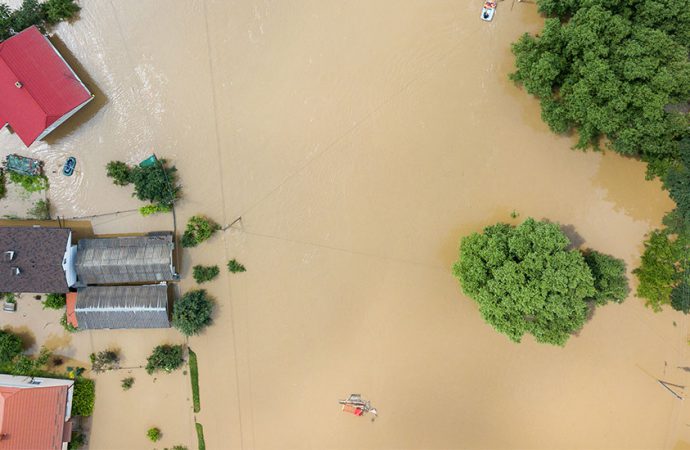The recent spree of floods in Pakistan will further wreck its already vulnerable economy. The geography of Pakistan and the ever increasing impacts of climate change make it more prone to natural disasters. With more than 7,253 known glaciers and nearly 51 small and large rivers in the Indus River System, Pakistan has always been
The recent spree of floods in Pakistan will further wreck its already vulnerable economy. The geography of Pakistan and the ever increasing impacts of climate change make it more prone to natural disasters. With more than 7,253 known glaciers and nearly 51 small and large rivers in the Indus River System, Pakistan has always been prone to flood related calamities. Moreover, shifting precipitation patterns, heat waves, melting of glaciers, and other climatic changes add to the existential threat of natural disasters. Despite all the predictions and worst disaster management experiences of the past, the NDMA and PDMAs were caught off guard again.
Since last two years or so, Pakistan’s economy has been in a precarious situation with rising current account deficit, lower industrial output, and negligible foreign investment. With global increase in crude prices, people of Pakistan experienced the worst inflation with prices of basic commodities soaring to unprecedented levels. In the midst of this chaotic situation, floods have caused inconceivable destruction to people’s lives and livelihoods. According to the UNHCR, over 30 million people are feared to have been affected by torrential rains and flash floods across the country, leaving 6.4 million people in need of immediate support. Since June, hundreds of thousands have been displaced by the floods.
The current state of Pakistan’s economy is not in a position to cope with the monetary fallout of floods. The country is in dire need of foreign aid, firstly to rehabilitate the flood affected population, and secondly, to keep the economic wheel moving. Floods and monsoon rains have swept away roads, crops, homes, bridges, and other infrastructure. According to Pakistan’s Planning Minister Ahsan Iqbal, the initial estimates show that losses incurred on the Nation might exceed $10 billion. He further added that the country would soon face food shortages and called current floods ‘deadliest’ in Pakistan’s history. In the end, he took a toll on western countries by saying that their ‘irresponsible development’ was the main cause of natural calamities in Pakistan.
Pakistan’s economy was passing through an adverse phase even before the floods. IMF agreed for a $1.1 billion bailout after strenuous round of talks and measures that caused the inflation rate to rise to 25%. According to the Minister for Climate Change Sherry Rehman, floods affected one third of the country’s land and population. Sindh remains the most affected Province followed by Balochistan and KPK. It is evident that floods will have devastating implications on Pakistan’s agriculture sector, upon which the economy depends the most. Prices of basic vegetables doubled and at times tripled in the capital city of Islamabad a week after floods hit Sindh and South Punjab. This points out to the anticipated hikes in the prices of basic commodities in the near future.
In 2010 Floods and 2005 Earthquake that shook the north of Pakistan, the Government and INGOs collaborated to assess the losses caused to different sectors of economy and then the donors helped Islamabad during the reconstruction phase after relief and rehabilitation. According to the Finance Minister Miftah Ismail, similar strategy would be adopted to mitigate the impacts of floods. According to the Ministry of Finance data, 2010 Floods destroyed or damaged more than 2 million hectares of standing crops, and more than 1.1 million houses were either completely destroyed or made unlivable. The estimated flood damages cost in 2010 according to the National Flood Reconstruction Plan 2010 was PKR 855 billion, and the reconstruction cost was estimated at PKR 578 billion. The agriculture sector bore the heaviest losses worth PKR 429 billion followed by housing and communication sectors.
The estimates for 2022 Floods are expected to go much higher as more area and infrastructure has been damaged as compared to the earlier floods. Rehabilitation and reconstruction would be an uphill task for federal and provincial governments. Apart from inflation, percentage of population living below poverty line is also expected to increase as floods have swept away people’s livelihoods in rural areas of Sindh, Punjab, and Baluchistan. For now, it is too premature to evaluate total losses and costs of reconstruction, as more energy is required for the relief and rehabilitation of the affected population. Management of disasters and rehabilitations may take years and at time decades.
A holistic approach is required to make the economy stand up on its feet despite the losses incurred due to floods. Policymakers must seek speedy ways to bring flood-relief aid from the international community. Federal Board of Revenue must be given strict targets of tax collection to fill the vacuum left within the economy. Other measures could be to revise the petroleum levy agreed with the IMF given the current crisis, which will make some room for the economy. Also, Pakistan could approach the IMF for rapid financing of $1 billion; a facility available to all member countries to meet their urgent needs including those arising from natural disasters. The government can further request the international community to reschedule bilateral loans, which will provide some relief to Pakistan’s falling reserves.
- Outcomes of the Shanghai Cooperation Organisation Heads of Government Summit - October 28, 2024
- Deliberations and Outcomes of the 79th Session of the UNGA - October 11, 2024
- SCO in Pakistan: Can it bring Normalcy in Indo Pak Relations? - September 26, 2024












Leave a Comment
Your email address will not be published. Required fields are marked with *